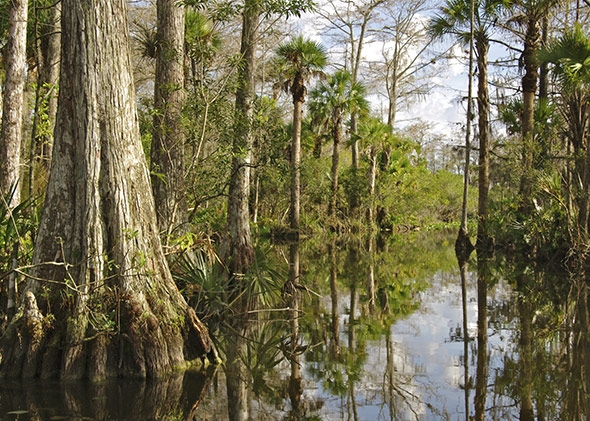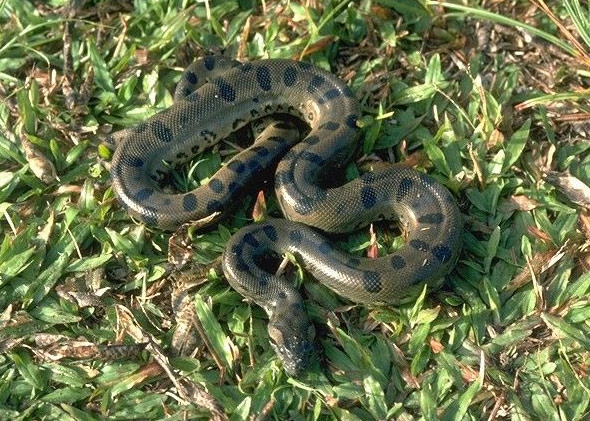
Photo by RicciPhotos/iStock
On a muggy day about 10 years ago in the Florida Everglades, Jack Shealy was riding his bike along a dirt road leading into the Trail Lakes Campground, where he has worked for decades. Like any good gladesman, Shealy has a substantial portion of his brain wired to recognize snakes in places where the rest of us would see only leaves and shadows. He skidded to a stop at the sight of a serpentine form stretched out in the sun.
This particular snake was not especially large—only about a meter in length. Yet the color was something different. Greenish brown with dark, oval spots. This was not a snake that belonged in the Everglades. Shealy did something that comes naturally to the family. (His nephew Jack M. Shealy recently became notorious for jumping into the water to wrestle an invasive Burmese python.) He jumped off of the bike and captured the angry snake by hand.
Trail Lakes Campground just happened to have a herpetologist on staff. Rick Scholle, who runs the campground’s roadside zoo, examined the snake and realized that he was looking at a juvenile green anaconda. A nonvenomous constrictor native to South America, the green anaconda is the biggest, heaviest species of snake in the world. It definitely does not belong in the Florida Everglades.
I met Shealy and Scholle while I was on an expedition in February to hunt invasive Burmese pythons in the Everglades. The Burmese pythons have become a well-publicized problem, but once I got down there and started spending time with the fishermen, bikers, reformed gator poachers, tour guides, smugglers, and biologists who inhabit the sparsely populated southern Glades, I found that the situation wasn’t everything it was made out to be on the evening news. The pythons were less of a problem than the media had made them out to be. And many other invasive species were crawling around without receiving nearly as much attention.
Hanging out with other python hunters, I realized within a few days that the vast majority of pythons had been captured by locals who just happen to bump into them while doing other things. Those locals see a lot of other weird things out there in the swamp. This is, after all, the home of the legendary skunk ape. Most people who think that they spot a skunk ape tend to keep the news to themselves for fear of sounding crazy, and until recently they felt the same way when they caught sight of a strange green snake big enough to swallow a Great Dane.

Courtesy of National Museum of Natural History Image Collection
I had a long conversation about green anacondas with Scholle one morning while he showed me the live 15-foot specimen in his own collection. The anaconda that Shealy had brought to him 10 years previously had refused to eat in captivity and died within a few months—which suggests the snake may have been born in the wild. Another green anaconda was later captured in the Everglades and given to Scholle. That snake gave birth to the behemoth wrapped around Scholle’s body as he spoke to me.
He pointed out that the Burmese pythons, as bad as their invasion seems, face a constraint on their numbers that the green anaconda doesn’t. The Everglades are riddled with another invasive species that has conquered most of the Gulf Coast: fire ants. Fire ants were brought to Gulf of Mexico ports accidentally by cargo ships from South America. They are notorious for attacking in swarms with extremely painful stings. Most ants have a bit of formic acid in their bite, but the fire ant also has a stinger equipped with a necrotizing venom.
Normally an animal stung by a fire ant will flee and survive. But creatures that can’t or won’t move away are at risk of being swarmed, killed, and eaten. Newborn calves are sometimes killed by fire ants before they can get to their feet. Burmese pythons are sometimes at a similar disadvantage. The females spend several months each year guarding their eggs by wrapping their bodies around them and defending against any would-be egg thieves. This places the python—and her leathery eggs—at risk of attack by marauding ants.
One Burmese python at Trail Lakes, captured in the wild and kept in a large outdoor enclosure, was swarmed by fire ants that tunneled up from beneath her while she guarded her eggs. By the end of the day she and her brood had been reduced to little more than scales and bones. Given the ubiquity of fire ants in the Everglades, it’s imaginable that the ants are limiting the population growth of the pythons.
The green anaconda does not have this problem. Unlike its smaller relative, the anaconda gives birth to live young rather than laying eggs. It can easily slither away from fire ant bites. What’s more, the anaconda would be less likely to encounter fire ants in the first place. Unlike the Burmese pythons, which are found on land and in trees as often as in the water, the green anaconda is an almost wholly aquatic snake. Perhaps this is why the green anaconda can afford to be about 50 percent heavier than a python of the same length. All of that enormous bulk is borne by the water most of the time.
Really large anacondas are rarely reported by white people, but African-Americans who live in or near the Everglades tell stranger stories. White people there usually go fishing the same way that I do—noisily and conspicuously. Standing up, constantly casting, and moving along to new spots when nothing is happening. But African-Americans of the Everglades have different fishing traditions. They sit very still and quietly along the water for a very long time with a piece of live or cut bait under a bobber. Waiting. When you wait quietly in nature that way, you tend to see things that other people don’t see. Like a great green and black snake as big around as a Hula Hoop, gliding slowly and smoothly past you through the dark water, so close you could almost touch it.
These stories of what could be record-breaking snakes are impossible to substantiate. Eyewitnesses are usually alone, and everything grows in a fisherman’s recollections. In most environments, a snake that large would be difficult to hide. But in the Everglades, living almost entirely in the water, a number of snakes large enough to swallow a man could spend their whole lives without ever being photographed or captured.
It is impossible to contemplate a snake so large without wondering whether it wouldswallow a human. The evidence for this ever having happened anywhere in the world is sketchy, but then again I suspect that the anacondas haven’t been filing their reports diligently and the victims have also been slow to talk.
Green anacondas haven’t gained much attention as an invasive species, but the state of Florida has become concerned enough about them that photos for identification were included in the study guide that I was assigned before participating in the “Python Challenge” hunting contest. Based on the specimens that people I’ve spoken to have collected, I am convinced that a breeding population of anacondas has become established. The questions are how many there are and how big they can really get.
In the long run, anacondas make the Burmese pythons look like garter snakes. Between their advantage over fire ants, sneaky aquatic lifestyle, and sheer size that discourages even the largest of alligators from messing with them, the green anaconda could eventually prove to be the biggest problem in the United States’ wildest place.
No comments:
Post a Comment